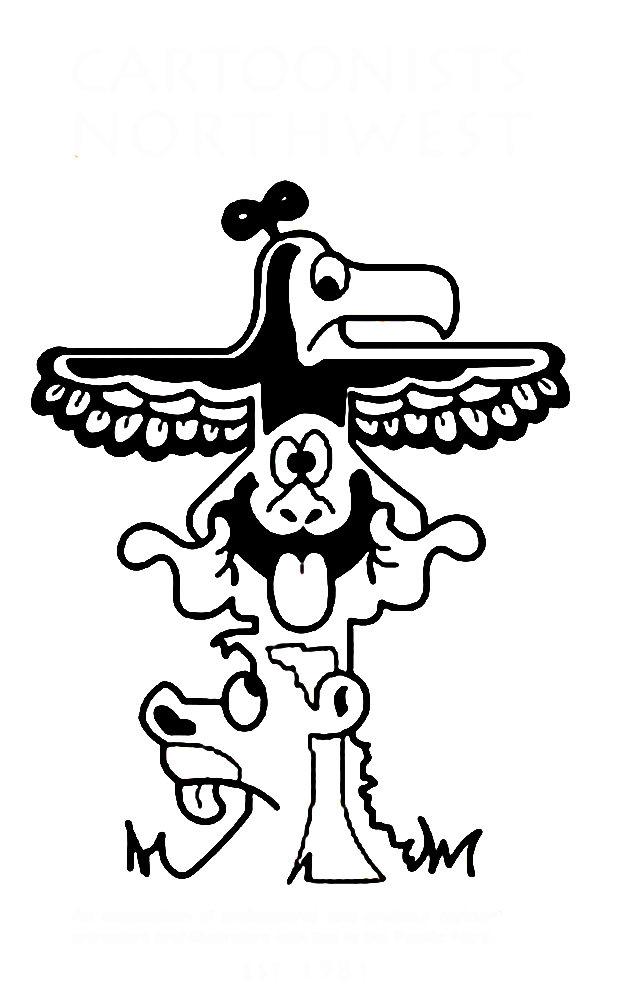The PEGs
everything you need in one book
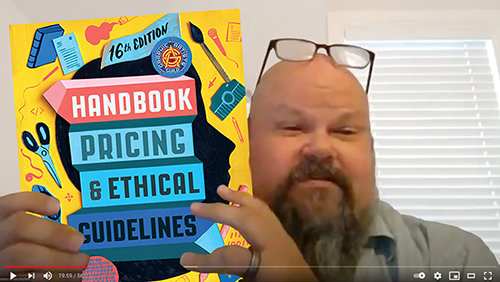
Cartoonists Northwest’s President Bill Morse explained that the Graphic Artists Guild published the latest (16th) edition of their Handbook for Pricing and Ethical Guidelines just a few weeks before our June meeting. It seemed appropriate to give an introduction to this bible of the visual arts industry. And who better to handle that than James Stowe, the Western Regional Representative of the Graphic Artists Guild since 2019. Cartoonist / Illustrator / Graphic Designer / Art Teacher, he is also a member of C.L.A.W. and CNW.
The Guild Handbook has been published almost every three years since the very first edition, a 20-page booklet, in 1973. This year the publication is a whopping four hundred forty-eight pages.
James was introduced to the Handbook by an Illustration Professor who considered it his only book for the class of illustration James was taking. And James has used the book as a reference ever since. For a long time, he didn’t realize the Handbook was associated with a Trade Organization.
“So let’s talk a little about what it does”, he began. “The Graphic Artist Handbook is created and compiled and edited and released quite a bit in its nearly fifty years of publication. It is, at its core, a comprehensive reference guide and best practices for graphic designers, illustrators, web designers, animators, Surface artists, and — which is why I’m here tonight — cartoonists.
It includes references and best practices on how to start and maintain your own successful graphic artist business. It contains pricing charts that are compiled by artists in our industry, and reviewed by experts in every graphic arts field. It is a salary guide for the employed. It has testimonies from the self-employed. And it has categories.
It is a resource for legal rights, for self-promotion, for trade conventions, for websites. You name it – there is something in the Handbook that can benefit you at just about every stage of what you do.”
James has used the Handbook for his entire career, always having a copy for reference since he first entered the business in 1994. He says it has been essential to his development as a graphic artist. And he wanted to share why that is.
Eight years ago, feeling he was no longer getting to be creative in his lucrative job as a Creative Director, James left that job to open James Stowe Illustraton:
It is still going strong today and he gives much credit to the Handbook.
This edition has been reorganized into five distinct parts:
- Part One focuses on running a successful graphic artist business. Chapters include best practices, maintaining professionalism and networking. How to maximize your income.
- Part Two is the Pricing Guidelines, what most people feel is the essential PEGs information. Compiled from pricing information of professionals in the field over the past three years. This is unique to the Guild Handbook. It asks them what they charge for what they do, creating a guideline for the industry.
- Part Three teaches you how to best protect your creative business and your intellectual property. A key and core fundamentals of the Guild is Advocacy for Creative Professionals, and part of that is Knowing your Legal Rights, and Contracts.
- Part Four contains eleven separate interviews with individual graphic artists throughout the disciplines and fields. Alongside examples of their artwork, it asks them interview-style how the Handbook has helped them in their careers. It is eye-opening.
- Part Five is the Resource and Reference Section, with all manner of recommended books, relevant publications, industry directories, promotional resources. Employment and freelance opportunities. Different organizations for graphic artists. Conferences and trade shows and merchandise markets. Useful software and tools. Online classes and courses. And informative websites and blogs.
The last half of the book is other resources that you can use to help with your business.
And there is the Appendix which is filled with references, aids and documents including: actual release forms, letters of agreement, estimate forms … everything you need to create the backbone of your pricing system.
Jean Pierre Magro
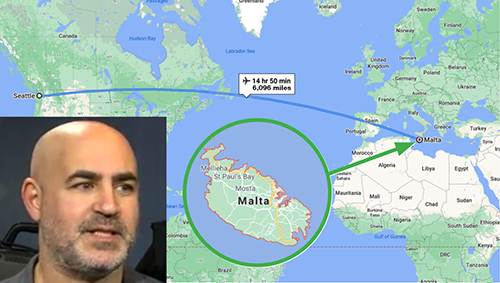
nomadic stories that move from one platform to another
may cnw meeting review
Jean Pierre Magro began by saying he was “very happy to be with (us) to discuss storytelling.”
By way of introducing himself, he explained he is from Malta, that little island below Sicily. Which, at 6,000+ miles from Seattle, surely means Jean Pierre is our most-distantly zoomed guest speaker ever.
His desire to be a storyteller started when he was young. There has always been a part of him that wondered why much of the world knows so little about his home. With all the rich history of Malta, so few can pinpoint it on a map, even though it has been featured in many historical events.
Some of us may erroneously rely on this reference: “In 1539, the Knight Templars of Malta paid tribute to Charles V of Spain by sending him a Golden Falcon encrusted from beak to claw with rarest jewels — but pirates seized the galley carrying this precious token and the fate of the Maltese Falcon remains a mystery to this very day”
“Storytelling, for me, was always extremely important. I was a documentary filmmaker, working for the History Channel and my films were shown on all major
stations. But after some point I got bored with the style of television history documentaries. So I decided to push forward my career, go back to studying, and
start analyzing stories from an academic perspective.”
Jean Pierre went to work in the US at a small media company, doing projects such as Ben-Hur and Pappillion series, until his confidence grew. And when he heard of Henry Jenkins’ “convergence media” he became fascinated with the subject. And realized stories are changing. He did his PHD in transmedia narratives. And from then on became completely fascinated in this new kind of storytelling.
He started advocating in Europe on new ways to tell stories. Talking to the decision-makers mostly, trying to help them understand how their audiences are changing. And why we need to start thinking in those terms. Especially nowadays when stories are actually brands, and brands become lifestyles. So if creators are not thinking in those terms, if becomes difficult to find an audience.
“So that was basically my journey so far,” he said. “Blood on the Crown,” which he wrote, stars Harvey Keitel and Malcolm MacDowell and chronicles how the citizens of Malta fought for independence from Britain in 1919. An upcoming film he has written, “Hounds of War,” is currently in pre-production.
Referencing Akira Kurosawa’s “Yojimbo,” and its opening sequence of the samurai walking down the road toward the camera, Jean Pierre shared the story of how Kurosawa was asked at a film festival why he had framed the shot that particular way. His honest answer was that if he had moved the camera one way there was a modern hotel, in the other direction an airport. An example of how sometimes in the moment a decision is made less as an artistic exercise as a practical one. People have studied and dissected “Yojimbo” for decades, and now we know a lot of that is over-analyzing.
“Stories are the most important thing we have,” he continued, “because they bind
us together, remind us of our humanity, they not only tell us that dragons exist but
that dragons can be beaten. And this is why humanity has always given so much importance to stories.”
“From Gilgamesh to James Bond, we continue to tell the same stories over and
over because that is what we need. Philosophy, religion & science confuse us, but
stories actually bring us together. But stories help us cope with the chaos in the world.
This is why they are extremely important,” Jean Pierre explained.
Transmedia (as some people call it) are nomadic stories that move from one platform to another. The more he studies it, the more he disagrees with people who say it is new, he feels it is not. Being from a strongly Catholic country, he believes that Catholicism has used every single platform over the centuries to tell its stories. In church practices, stories are told, costumes are worn in reenactments, stories are sung to beautiful music (which is intended to aid in telling your story), you have statues and paintings which help expand the stories, and then you have plays as well. And with the internet, on your computer, you can encompass every platform; you can read on it, you can watch, you can listen, so it has all these things. There is a convergence of all of this media.
But the entertainment industry is extremely slow in adopting all these new things. Because there is money involved, investment. And previous investments, such as Smell-O-Vision in the 1960s which was a massive flop. Then big industry becomes wary of the next new thing, such as Intra-Film in the early 2000s, where once the main character has to make a decision, the film stops, the lights in the theatre come on, the audience votes which affects how the movie continues … and it just didn’t work. So it is understandable why the film industry has this trust problem with jumping on board.
This media crossover is done well on the internet. Japan pioneered “media mix” in the 1960s. You would read manga for volume after volume, then the story continued in anime.
This enlightening and informative meeting review can be watched in its entirety online.
“That’s the Sort of Nonsense I’ve Been Up To For The Past 40 Years”

Our Cartoonists Northwest guest speaker for March 2021 was author, storybook artist, cartoonist, Godfather of Storyboarding, Mark Simon.
“Hi, everyone! I have a brief three-hours-done-in-ten-parts presentation, I’m really looking forward to giving to you”, Mark quipped.
“I’m known mostly as a Story Artist,” Mark began, “but have had many art careers. So I thought the most fun thing would be to show you where I came from and then some samples of what I’ve done recently. And then we’ll do some Q&A, if anyone wants to hear my voice at that point.”
Mark has been working in Hollywood for well over thirty years. He’s been involved in over five thousand (and close to six thousand) productions in that time. He’s done everything from big features to small, tv series and commercials, music videos, industrial videos.
“You name it”, he summed up.
His design career began when he was a twelve-year-old competitive skateboarder. Unhappy with the skateboards available in the 1970s, he designed his own, then a line of 4 or 5 plus stickers. And then he sold it all to Schwinn Bicycles.
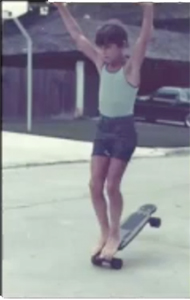
In High School he drew for the school newspaper. He redesigned/rebuilt all the sets for the school theatre dept. where he was Backstage Manager, which led to a college scholarship. And he got bullied by gangs. Small for his age and unwilling to take any bulls**t, he was attacked by thirty gang members one night while at a party. He escaped but was followed home and his entire family was now threatened. Later, after court battles in which the gang members’ parents were held responsible, he told the story in his book “Attacked”.
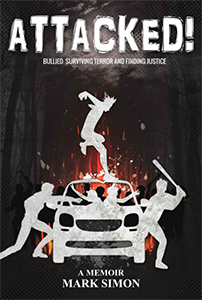
In College, Mark became the School Cartoonist, doing editorial cartoons for the school newspaper, and a comic strip called “Roomies”. When told some of his stuff was not suitable for print in the school paper, he launched his own publication “The Belligerent Beacon”. The Beacon was distributed at four other universities.
Also while in college, Mark was studying Marketing and running his own advertising agency. In the end he graduated with a degree in Film and thought, “Hollywood sounds cool”. He sold his business, packed up and moved to the Los Angeles area. Nearby was Filmation Studios, doing He-Man at the time, Mark went in to offer his skills but flunked their test and didn’t get work.
Then he saw an ad for Roger Corman’s studio, where half of Hollywood gets their start, for a Construction Coordinator on the upcoming feature “Beyond Infinity”. He got the job, was promoted quickly to Art Director and then realized it was a soft porn flick called “Slavegirls from Beyond Infinity”. Relying on things he’d read in Cinefex magazine, he did the work and has not been out of work since. Mark has done Set Design, Art Direction, on movie after movie, production after production, commercial after commercial.
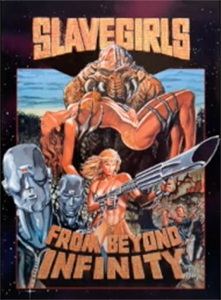
But Mark wasn’t getting to draw very much. So he took some sample storyboards to Storyboard, Inc. the largest such place at that time. He got hired for some commercials, began storyboarding projects on which he was Art Director.
In Oct 1989, the Loma Prieta earthquake hit, his then-fiancée (now his wife) said they had to leave LA, so he turned down his next job and they moved to Orlando, Florida. Universal and Nickelodeon were just opening, he and his wife both got work at Nickelodeon.
At the same time, Mark created a strip called “Hollyweird”, which satirized his experiences in LA. When he showed the strip to a couple of syndicates, Columbia Features signed him up. He created all his own marketing, wrote/draw a year of strips, as launch date neared he learned they’d gone out of business.
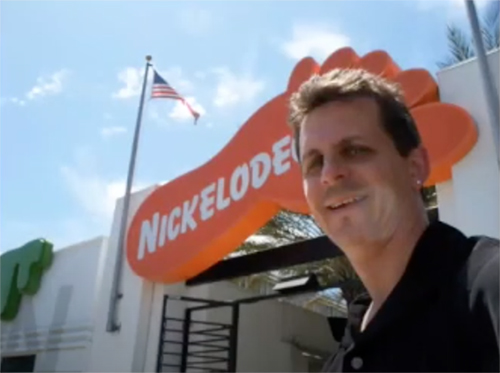
Through connections, Mark worked as a Consultant on the first eight-two episodes of Dragon Tales. The show went to number one in its first year — and he got to thinking of animation again.
Mark bought a digital ink and paint system to learn how that worked after being Director of Story on “Barbie: Video Game Hero”. He developed a portfolio of samples and found out Disney had brought in a small independent company to do their 2D animation. He snuck onto the lot, met the President of this company, showed his samples and landed a $60,000 contract to animate Tinker bell for the Disney Cruise Line. And this launched Mark’s animation studio.
Mark storyboarded the very first episode of “Dexter”, and “The Waterboy”. He’s storyboarded everything from Woody Woodpecker to Stranger Things to the Walking Dead to Black Lightning to Fear the Walking Dead. He’s written articles for animation business magazines and seven (7) books.
And a lively Q&A session rounded out the meeting.
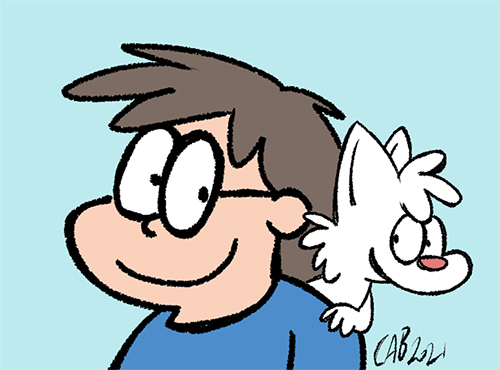
Charles Brubaker was our guest speaker for the March meeting of CartoonistsNorthwest.
His “first big break” was selling a gag to Spongebob Squarepants magazine. And he has sold more than a few since then. MAD Magazine has also published his work.
Around the time of his first Spongebob work, Charles created “Ask a Cat” which was picked up by GoComics.com. The premise was straightforward; Ask a Cat is a comic strip where people can finally get answers from a cat. Ever wondered why cats love boxes? Or what cats think of humans? Or what they really think of dogs? Wonder no more, as Cat answers them all.
Next, Charles created “Fuzzy Princess”, starring Katrina the adventurous feline princess of St. Paws, and her pals Chiro and Kuma. Now they’ve been stranded in our world! Can Kat’s new human friend Jackson help them survive?
Charles has been doing mostly comics since 2019, but his goal is to work in animation. He showed us an early film he created when he was in college.
Moving to LA hoping to break into animation, to get a job at Nickelodeon, didn’t work out. However, Charles met a storyboard artist for Spongebob
Squarepants who helped him get work drawing for Spongebob magazine. “That was one of my favorite jobs”, Charles remembered, “so my trip to LA was not a
total loss.”
As for animation software, he has tried Flash, Flip, Toon Boom, a variety of them and liked them little. Now he’s using ClipStudioPaint.
When Steve Greenberg asked how he does synchronizes audio in his animations, Charles says it is work-intensive and he uses Audio Scrubbing. His work process is to listen to the voice audio over and over to get it right. Then again, when there’s some fast talking you can sometimes “take liberties”.
With all of Charles’ comic strips and characters, he has plenty of material to use in animation.
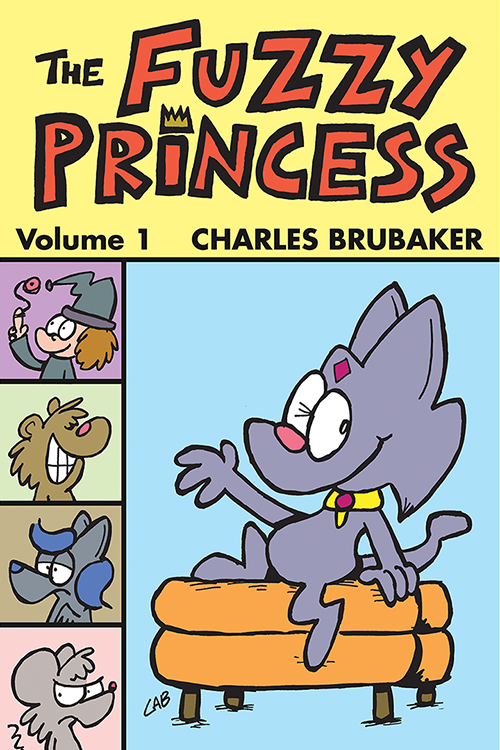
Rick Hoberg guest speaker
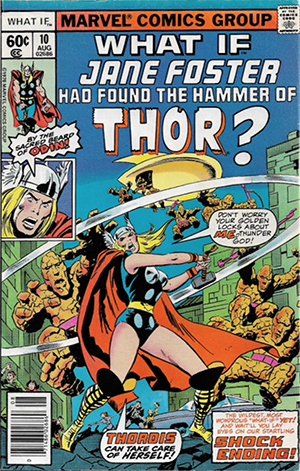
“I’m just here to chat with you guys,” began Rick Hoberg the Guest Speaker at Cartoonists Northwest’s February 2021 meeting.
In 1972, Rick was the president of a local comic book club, it helped him get introduced to legendary comic book / comic strip artist Russ Manning. A few months later, Russ called Rick to join his group of creatives who were producing the Tarzan family of comics that Edgar Rice Burroughs, Inc. was having published for the overseas market. Bill Wray was also in this group. But nine months later ERB shut the publishing down due to slow sales.
Mark Monlux asked, “How did you go to work at Marvel Comics?”
Rick was attending art school in California when Roy Thomas, writer/editor at Marvel, moved out west. Roy remembered Rick’s work on Tarzan, hired him for drawing assignments on Conan, Star Wars, What If..? and other titles.
Roy had convinced Marvel Comics to buy the rights to the upcoming movie Star
Wars for comic book adaptation. He signed Howard Chaykin and Steve Leialoha to be the lead artists — but they had difficulty maintaining the monthly publishing deadlines. Soon Rick was asked to draw the covers for issues #3, 4, 5, 6 – it launched Rick’s career. And to this day, he continues to receive checks for Marvel Star Wars reprints.
A move to DC reunited Rick with Mark Evanier (a writer/editor on the Tarzan comics) doing Blackhawk. He also got to draw his favorite comic book and its characters when All-Star Squadron was assigned to him.
Then at small, independent publisher Renegade Press, Rick created and drew the adventures of Eternity Smith.
A career move to animation beckoned and Rick hired on at Hanna-Barbera where he met and worked under Doug Wildey (who created Jonny Quest among other achievements). Wildey had him doing storyboards on Godzilla and Jana of the Jungle.
Animation offered better opportunities, better pay, retirement benefits — things comic books couldn’t. Rick worked with the likes of Ralph Reese, Dave Stevens, and Will Meugniot.
Ruby-Spears hired Rick away from H-B to work on Plastic Man and Thundarr the Barbarian (collaborating with Jack Kirby and Steve Gerber).
Rick’s career includes being a storyboard artist, model designer and layout person at H-B, Ruby-Spears, Filmation, Marvel Productions, Marvel Films, DIC Entertainment, Universal Studios, Disney, Cartoon Network, Warner Bros., and others. He has contributed to Godzilla, Super Friends, Spider-Man and His Amazing Friends, The Incredible Hulk, G.I. Joe, Spider-Man, Justice League, X-Men, and Teenage Mutant Ninja Turtles.
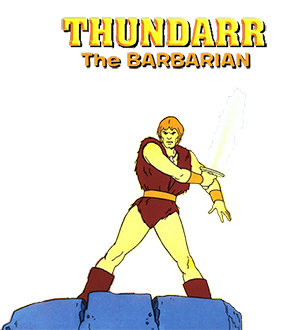
A bit more work in comics for Roy Thomas, now at DC, included Captain Carrot, BatMan, and Green Arrow written by Mike Grell and set in Seattle.
And let’s not forget to mention Rick’s Lucasfilm Licensing work. He created style sheets for every movie up to “Solo”.
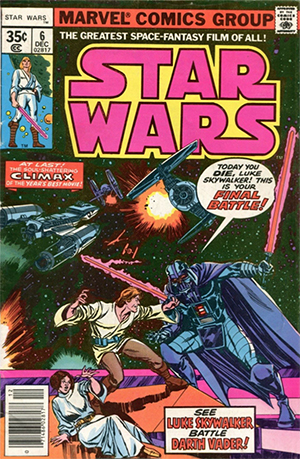
Rick has always been a huge fan of Milton Caniff’s Steve Canyon and spent a bit of pandemic-shelter-in-place hours catching up on those adventures. He loves the work of the late Darwyn Cooke. He never was much interesed in drawing “two people having coffee”-type of stories. Rick still “has a monthly gig” for MicroSoft. Feels Gil Kane was one of the three top Spider-Man artists of all time (Steve Ditko is Number One). Drew about three months of the Star Wars newspaper comic strip following the death of Russ Manning. Is a big fan of Russ Heath and Mike Sekowsky, and was thrilled to ink Sekowsky pencils on a comic book once.
